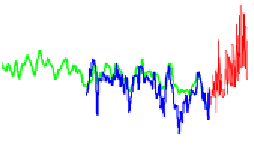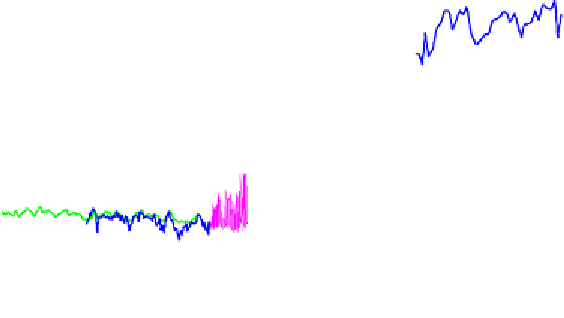Geoscience Reference
In-Depth Information
proxies in Figure 2.8 to the following two composite lines: firstly, lean0, for
its proportionality to sun spots, and secondly timv15, which is the most
recent (2014). In this way, we are able to obtain the four reconstructions
given in Figure 2.12, in the graphs on the left.
Usoskin
e
t be10,
c
onnected
t
o timv15
Calib
r
ation a
n
d alignment on
timv15
1362
1362
1361
1361
Usoskin
Be10
t
imv15
1360
1360
1359
1359
0
500
1000
1500
2000
1500
1600
1700
1800
1900
2000
Usoskin
et be10,
c
onnected
to lean0
Cali
b
r ation
a
nd alig
n
ment o
n
lean0
1362
1362
1361
1361
Usoskin
Be10
l
ean0
1360
1360
1359
1359
0
500
1000
1500
2000
1500
1600
1700
1800
1900
2000
Figure 2.12.
Four irradiance reconstructions
In order to carry out the splicing, we determine by least squares, over the
period of overlap, an affine transformation
y = ax + b
between reference
y
(lean0 or timv15 as appropriate) and the series
x
to be connected.
Subsequently, we apply the relation obtained for the whole series
x
, and
connect from 1700 onwards. The graphs on the right in Figure 2.12 highlight
the quality of the connection, significantly better for irradiance than they are
for temperatures (see Figure 2.4). Other options could have been considered;
the analysis of principle components, for instance, or possibly using non-
centered PCAs. Fortunately, the quality of the overlap is good enough so that
the technique used only has a minimal impact on the result.
Depending on the option (lean0 or timv15), the amplitude of the
excursions ranges from around one to three. As a result, it is not surprising to
identify solar sensitivity coefficients which have the same ratio, according to
the reconstruction adopted.

















































































































































































































































Search WWH ::

Custom Search